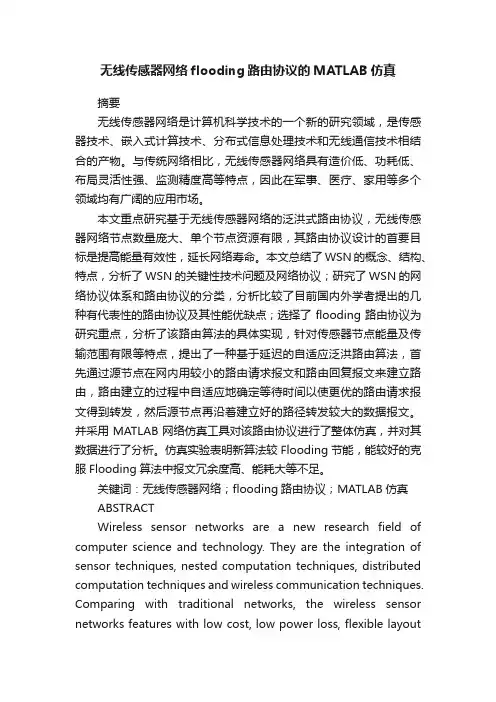基于matlab的无线传感器网络_毕业设计论文
- 格式:doc
- 大小:944.00 KB
- 文档页数:46

物联网工程课程设计
基于Matlab的无线传感器网络节点定位仿真
姓名:
学号:
班级:
二○一六年六月
目录
一、绪论 (1)
1.1 研究背景 (1)
1.2 研究意义 (1)
1.3 研究内容 (1)
二、设计要求及方案 (1)
2.1 设计要求 (1)
2.2 设计方案 (1)
三、基于无线传感器网络节点定位算法 (1)
3.1 定位算法简介 (1)
3.2 三角测距定位算法 (1)
四、定位算法在Matlab下仿真 (1)
4.1 参数设定 (1)
4.2 仿真实验 (1)
4.3 实验分析 (1)
五、结论..................................................... 错误!未定义书签。
参考文献..................................................... 错误!未定义书签。
一、绪论
1.1 研究背景
1.2 研究意义
1.3 研究内容
二、设计要求及方案
2.1 设计要求
2.2 设计方案
三、无线传感器网络节点三角定位算法
3.1 定位算法简介
3.2 三角测距定位算法
四、定位算法在Matlab下仿真
4.1 参数设定
4.2 Matlab代码及仿真结果
4.3 实验分析
五、结论
参考文献
[1] 董跃钧基于ZIGBEE技术的室内定位算法研究及应用数字技术与应用2012年
1。

基于MATLAB的无线传感器网络优化设计一、引言无线传感器网络(Wireless Sensor Network, WSN)是由大量分布在监测区域内的自组织、协同工作的无线传感器节点组成的网络系统。
WSN已经被广泛应用于环境监测、智能交通、医疗保健等领域。
在设计无线传感器网络时,如何合理地选择传感器节点的部署位置、优化网络结构以及提高网络性能是至关重要的。
二、MATLAB在无线传感器网络设计中的应用MATLAB作为一种强大的科学计算软件,提供了丰富的工具箱和函数,可以帮助工程师和研究人员进行无线传感器网络的优化设计。
通过MATLAB,可以进行网络拓扑结构设计、能量消耗分析、数据传输模拟等工作,为无线传感器网络的性能提升提供有力支持。
三、无线传感器网络优化设计的关键问题1. 传感器节点部署优化在设计无线传感器网络时,合理选择传感器节点的部署位置对于网络覆盖范围、能耗均衡等方面至关重要。
通过MATLAB可以进行传感器节点部署方案的仿真和优化,找到最佳部署策略。
2. 路由优化路由是无线传感器网络中的重要问题之一,影响着数据传输的效率和稳定性。
利用MATLAB可以对不同的路由算法进行仿真比较,找到最适合特定场景的路由优化方案。
3. 能量管理能量是无线传感器网络中最宝贵的资源之一,如何有效管理传感器节点的能量,延长网络寿命是设计过程中需要考虑的重要问题。
MATLAB可以帮助分析能量消耗模型,优化能量分配策略,实现能量的有效利用。
4. 数据融合与处理在大规模无线传感器网络中,海量数据需要进行有效融合和处理,以提取有用信息。
MATLAB提供了丰富的信号处理工具箱,可以帮助实现数据融合算法,并对数据进行高效处理。
四、基于MATLAB的无线传感器网络优化设计实例以某环境监测应用为例,假设需要设计一个无线传感器网络来监测空气质量。
首先利用MATLAB对监测区域进行建模,并根据空气污染源分布情况确定传感器节点部署位置;其次通过MATLAB仿真不同路由协议下数据传输效率,并选择最佳路由方案;然后利用MATLAB对能耗模型进行建模和仿真,优化能量管理策略;最后利用MATLAB对采集到的数据进行融合处理,得出空气质量监测结果。

MATLAB在无线传感器网络中的应用指南在现代科学和工程领域中,无线传感器网络(Wireless Sensor Networks,简称WSN)的应用越来越广泛。
WSN由大量小型无线传感器节点组成,这些节点能够自主感知、采集数据,并通过无线通信网络将数据传输至集中器或数据中心。
WSN已被应用于气象监测、环境监测、农业、健康监护等众多领域。
在WSN的开发和研究过程中,MATLAB作为一种强大的工具和编程语言,发挥着重要的作用。
一、WSN的节点设计与仿真在WSN中,节点的设计和仿真是非常关键的一步。
节点的设计涉及到硬件选择、电力管理、信号处理等方面。
而MATLAB作为一种强大的数学计算和仿真平台,可以用来进行节点电路的建模和仿真。
通过MATLAB的仿真工具箱,我们可以模拟不同节点设计的性能,并根据需求进行优化。
例如,我们可以使用MATLAB中的Simulink仿真工具箱来建立一个节点的能耗模型,并对不同的电源管理方案进行仿真分析。
这些仿真结果可以为节点设计和性能优化提供指导。
二、WSN的信号处理与数据分析在WSN中,节点通过传感器感知到的物理信号需要进行适当的信号处理和数据分析。
MATLAB提供了丰富的信号处理工具箱,可以用于节点感知信号的预处理、滤波、降噪等操作。
此外,MATLAB还有强大的数据分析和可视化工具,可以帮助用户对节点采集到的数据进行统计分析、特征提取、模式识别等工作。
通过MATLAB,我们可以方便地对WSN数据进行处理和分析,得到有用的信息和结论。
三、WSN的网络协议设计与优化在WSN中,节点之间的通信是无线的,因此网络协议的设计和优化显得尤为重要。
MATLAB提供了用于无线通信和网络建模的工具箱,可以用于WSN网络协议的设计和性能评估。
通过MATLAB,我们可以模拟和优化WSN网络的拓扑结构、路由算法、功率控制和数据传输效率等方面。
此外,MATLAB还可以用于分析网络中的信道传输特性、干扰和抗干扰能力等参数,帮助用户设计高效、可靠的WSN网络协议。

学士学位论文无线传感器网络节点定位算法的Matlab仿真——质心算法的Matlab仿真姓名:学号:院系:专业:通信工程指导教师:申请学位:工学学士二○一四年三月学位论文原创性声明本人重声明:所呈交的论文是本人在导师的指导下独立进行研究所取得的研究成果。
除了文中特别加以标注引用的容外,本论文不包含任何其他个人或集体已经发表或撰写的成果作品。
本人完全意识到本声明的法律后果由本人承担。
作者签名:年月日学位论文使用授权书本学位论文作者完全了解学校有关保障、使用学位论文的规定,同意学校保留并向有关学位论文管理部门或机构送交论文的复印件和电子版,允许论文被查阅和借阅。
本人授权省级优秀学士学位论文评选机构将本学位论文的全部或部分容编入有关数据库进行检索,可以采用影印、缩印或扫描等复制手段保存和汇编本学位论文。
本学位论文属于:1、□,在_________年解密后适用本授权书。
2、不□。
(请在以上相应方框打“√”)作者签名:年月日无线传感器网络节点定位算法的Matlab仿真以达(师学院通信工程系, 653100)【摘要】无线传感器网络集成了传感器技术、微机电技术、现代网络和无线通信技术,已成为当前IT领域研究的热点之一。
由于其具有网络自组织、覆盖广以及高容错性等固有优点以及组网成本低、构建灵活、方便等特点,使得无线传感器网络在军事、民用等领域应用广泛。
节点定位技术是无线传感器网络的关键支撑技术之一,节点自身的正确定位是提供监测事件位置信息的前提。
本文研究了无线传感器网络节点定位算法的原理、分类和难点,分析研究了不同定位算法的原理并比较了他们优缺点。
针对无线传感器网络节点定位技术进行了系统研究,提出了一系列解决无线传感器网络节点定位问题的方法,并结合科研及实际需要进行学习和研究。
最后,本文设计实现了无线传感器网络定位应用系统基于Matlab进行了仿真实验。
【关键词】无线传感器网络;质心算法;节点定位;MatlabAbstract: Wireless sensor network integrated sensor technology, MEMS technology, modern networking and wireless communications technologies, IT has become one of the hot areas of current research. Because of its self-organizing network, the inherent advantages of wide coverage and high fault tolerance and low cost network, build flexible, and convenient, making wireless sensor networks are widely used in military and civilian fields. Node positioning technology is a key enabling technology for wireless sensor network node itself correctly positioned to providelocation information to monitor events premise. This paper studies the wireless sensor network node localization algorithm principle, classification and difficulties, analysis of the principle of different positioning algorithms and compare their advantages and disadvantages. Conduct for wireless sensor network node positioning system technology research, proposed a series of solutions to the problem of wireless sensor network node localization, combined with the practical needs of research and learning and research. Finally, the design and implementation of a wireless sensor network positioning application system based on Matlab simulation experiments.Key words: Wireless sensor networks; centroid algorithm; node localization; Matlab目录一、绪论 (1)1.1 研究背景 (1)1.2 研究意义 (2)1.3 研究容 (3)二、设计要求及方案 (4)2.1 设计要求 (4)2.2 设计方案 (6)三、无线传感器网络节点定位质心算法 (7)3.1 定位算法简介 (7)3.2 三边测距定位算法 (8)3.3 质心定位算法 (10)四、定位算法在Matlab下仿真 (11)4.1 参数设定 (11)4.2 仿真实验 (12)4.3 实验分析 (18)五、结论 (19)致谢 (20)参考文献 (21)一、绪论1.1 研究背景随着微电子技术和无线通信技术的飞速发展和不断成熟,具有感知能力、计算能力和通信能力的无线传感器网络孕育而生。

如何使用Matlab进行无线传感器网络设计和优化使用Matlab进行无线传感器网络设计和优化无线传感器网络(Wireless Sensor Networks,简称WSN)是一种由大量分布式传感器节点组成的网络系统,通过无线通信协作进行数据采集和传输。
在各个领域中,WSN的应用范围越来越广泛,并且对网络的设计和优化提出了更高的要求。
本文将介绍如何使用Matlab进行WSN的设计和优化,以帮助读者更好地理解和应用此工具。
一、Matlab介绍及其在WSN中的应用Matlab是一种高级技术计算语言和环境,具有强大的数据分析和建模能力,尤其适用于科学和工程问题的解决。
在WSN中,Matlab可以用于设计、建模和分析网络通信协议、节点部署和能量消耗等方面的问题。
通过Matlab提供的各种工具箱和函数,可以实现WSN的仿真、优化和性能评估。
二、WSN设计中的关键问题在设计WSN时,需要考虑以下关键问题:1.节点部署:合理的节点部署是保证网络性能和能量效率的重要因素。
在Matlab中,可以使用图形处理和优化算法来确定最佳的节点部署策略,并在仿真中验证其有效性。
2.能量管理:WSN中节点的能源是有限的,因此如何管理和优化节点的能量消耗是一个重要的问题。
Matlab提供了多种能量管理算法的实现,可以用于节点睡眠调度、能量平衡和能量感知等方面的研究。
3.路由协议:在WSN中,节点之间的通信通过路由协议来实现。
设计高效的路由协议是提高网络性能和可靠性的关键。
Matlab中提供了各种路由协议的实现和性能评估工具,可以用于比较和选择最适合的路由策略。
三、使用Matlab进行WSN节点部署节点部署是WSN设计的第一步,合理的节点部署可以提高网络的覆盖率和通信质量。
在Matlab中,可以使用图形处理和优化算法来实现最佳的节点部署策略。
首先,可以通过Matlab的图形处理工具箱创建网络拓扑图,然后使用网络分析和优化算法找到最佳的节点部署位置。

在Matlab中进行传感器网络与无线通信一、引言在当今的信息时代,无线通信和传感器网络的发展日新月异。
而在这个快速推进的过程中,Matlab作为一款强大的工具软件,不仅能够辅助设计和模拟无线通信系统,还能帮助开发和测试各种传感器网络的应用。
本文将介绍在Matlab中进行传感器网络与无线通信的相关工具和方法,探讨其在实际应用中的意义和价值。
二、传感器网络与无线通信1. 传感器网络的概念及应用传感器网络是一种由大量具有自主智能的传感器节点组成的互连网络系统。
传感器节点能够自组织、自配置,并能共同协作完成一系列任务,如数据采集、处理和传输等。
传感器网络广泛应用于环境监测、智能交通、农业、医疗等领域,为实时监控和数据获取提供了有效手段。
2. 无线通信技术的发展与应用无线通信技术是传感器网络实现信息传输的重要手段,其发展经历了从2G到4G再到5G的迭代升级。
无线通信技术的进步不仅提高了通信速率和容量,还增加了网络的可靠性和稳定性。
如今,无线通信已经深入到人们的生活中,无处不在,为人们的沟通提供了更便捷的方式。
三、Matlab在传感器网络中的应用1. 传感器网络的建模和仿真Matlab提供了丰富的工具和函数,可以用于传感器网络的建模和仿真。
通过Matlab的Simulink和Stateflow工具,可以构建传感器节点和网络的模型,并进行系统级的仿真和验证。
这有助于设计优化传感器网络的拓扑结构、通信协议和能量管理策略,提高网络的性能和功耗效率。
2. 传感器数据分析和处理传感器网络收集到的数据往往包含了大量的噪声和冗余信息,需要进行有效的分析和处理。
Matlab提供了丰富的信号处理和数据分析工具包,如滤波、降噪、特征提取等,能够帮助研究人员对传感器数据进行精确的分析和提取,提高数据的可靠性和有效性。
3. 传感器网络的可视化和结果展示Matlab具有强大的图形绘制和数据可视化功能,可以将传感器网络的拓扑结构、节点状态和数据结果进行直观的展示。

1 引言1.1 背景和发展俗语有云“水火无情”。
当今,火灾是世界各国人民所面临的一个共同的灾难性问题。
它给人类社会造成过不少生命、财产的严重损失。
随着社会生产力的发展,社会财富的日益增加,火灾损失上升及火灾危害范围扩大的总趋势是客观规律。
据联合国“世界火灾统计中心”提供的资料介绍,发生火灾的损失,美国不到7 年翻一番,日本平均16 年翻一番,中国平均12 年翻一番。
全世界每天发生火灾1 万多起,造成数百人死亡。
近几年来,我国每年发生火灾约4万起,死2000多人,伤3000—4000 人,每年火灾造成的直接财产损失10 多亿元,尤其是造成几十人、几百人死亡的特大恶性火灾时有发生,给国家和人民群众的生命财产造成了巨大的损失。
严峻的现实证明,火灾是当今世界上多发性灾害中发生频率较高的一种灾害,也是时空跨度最大的一种灾害。
因此,火灾的监控成为科研工作的一大课题。
随着科技的进步, 现代火灾监控系统正朝着分布式、网络化、智能化的方向发展。
人们不仅要求系统稳定可靠, 功能齐全, 而且还要求能够结合无线通信的优势, 实现无线监控, 实时掌握系统的运行状态。
传统的火灾监测系统主要安装红外或微波等各种类型的报警探测器, 通过有线方式与计算机安全综合管理系统联网, 计算机系统对报警系统进行集中管理和控制。
由于电子设备长期处于运行状态, 电气设备过载、过热、短路的火灾隐患较多。
因此, 传统的火灾监控系统本身存在着很多的安全隐患。
本次设计便运用了无线传感器网络和动态机器人联合工作的思想设计了火灾监控系统。
该系统共有传感器节点、机器人节点、危险敌对区域搜索节点和远端用户节点四种节点。
无线传感器网络是由大量的具有温度、湿度采集功能、无线通信、计算功能的微小传感器节点构成的自组织分布网络系统。
每个节点具有数据采集与路由功能。
传感器节点最后把数据都发送到机器人节点处,机器人节点相当于网关负责融合、存储数据,并把它传送到Internet或卫星网络上将信息传给用户节点。

Development of Fire Detection Systems in the Intelligent BuildingZ. Liu, J. Makar and A. K. KimInstitute for Research in ConstructionNational Research Council of Canada, Ottawa, CanadaIntroductionAn intelligent building can be defined as one that combines the best available concepts, designs, materials, systems and technologies to provide a responsive, effective and supportive intelligent environment for achieving the occupants objectives over the full life-span of the building. Compared with traditional buildings, intelligent buildings should be able to reduce energy consumption, reduce maintenance and service operation costs, provide improved security services, improve ease of layout planning and re-planning, and increase the satisfaction of building occupants. Other benefits should include its adaptability to changing uses and technology and its environmental performance in providing safer, healthier and more comfortable working conditions. Intelligent building proponents also believe that these buildings will improve worker productivity through improved work environments. Over the last two decades, the intelligent building concept has become an important consideration in the planning of many new or upgraded office buildings. It has also been further developed to embrace other types of living and working environments such as homes, factories and education facilities.Fire detection and the corresponding safety systems are crucial parts of an intelligent building. Billions of dollars are spent annually to install and maintain fire detection systems in buildings to assure safety from unwanted fires. Intelligent systems developed in the intelligent building offer opportunities to meet this task more effectively, efficiently and economically. New sensors will produce earlier and more reliable fire detection. Wireless systems will eliminate the need for cabling and offeropportunities for fire fighters to work out fire fighting strategies before arrival at the fire scene. Integrated building systems hold the potential for reducing false alarms, speeding building evacuation and assisting in fire fighting. These changes will create new ways to provide fire safety and new markets for fire detection, alarm and fighting systems. As these technologies mature, changes to building practices may also result.This paper reviews the current state of the art for fire detection and alarm systems in intelligent buildings. It identifies new technologies and concepts developed for intelligent buildings that could be used to improve the capability of fire safety systems. The potential effects of integrated building service systems and barriers to the development of fire detection and alarm systems in intelligent buildings are discussed. The paper concludes by examining how these new systems may be combined to provide the next generation of intelligent fire safety systems.Emerging Sensor TechnologiesNew sensor technologies will be key components in the next generation of intelligent buildings. Current intelligent buildings often have embedded processors and dedicated information networks. The new generation is expected to add the capability to learn about the building ís circumstances and its occupants needs and change the behavior of its control systems accordingly. The employment of a large number of sensors within the building will allow it to operate in a responsive manner, rather than using preprogrammed control models as are employed in the first two generations of intelligent building. The information provided by sensors includes changes in both internal and external environments of a building, such as smoke, temperature and humidity, air quality, air movement, and the number of building occupants as well as a host of other properties. The system will use sensors to identify how a particular person tends to react to particular circumstances and to learn different behaviors for different people.The number of sensors required to obtain this type of functionality is quite high,especially since one of the major goals of intelligent buildings is to allow individualized control of an environment. This need will increase the cost of intelligent buildings and make it difficult to manage the resulting large amount of data. Development of cost-effective sensors has consequently been identified as a key need for intelligent buildings. Fortunately, many of the properties that need to be monitored can be used for multiple purposes. Security systems that can track the entry and exit of occupants from an office building can also be used to ensure complete evacuation of a building during a fire or even, in more advanced forms, determine where occupants may be trapped and unable to escape. Similarly, parameters such as temperature and air movement are as relevant to fire detection as the maintenance of the indoor working environment. Dual use sensors and sensor systems that are flexible enough to interpret data from different events will be key to making cost efficient intelligent buildings. Efforts are being made to develop multi-function sensors for simultaneously detecting fire and monitoring indoor air quality (IAQ). Multi-function sensors that combine inputs from several different chemicals or physical processes would be expected to reduce the rate of false alarms and increase the speed of detection of real problems. They should therefore enhance fire safety while at the same time lowering total system costs. The chemical gas sensor has potential for this type of application. Chemical sensor techniques are now available for measuring almost any stable gaseous species emitted from materials and prior to or during combustion. Chemical species can be sensed through a multitude of interactions, including catalytic, electrochemical, mechanic-chemical, and optical processes. In one square inch, several hundred individual sensors can be placed in an array. By coating each sensor with a different semi-conducting material, several hundred different readings for gas signatures can be made by an expert system. Recently, one olfactory sensor array system has been developed for environmental monitoring and for fire and smoke detection. Such a system consists of an array of broadly-selective chemical sensors coupled to microprocessor-based pattern-recognition algorithms so that the changes in environmental conditions, such as CO, CO2 and smoke, can be detected.A major issue in any sensor system is differentiating between different causes of the event being detected. Higher than expected levels of CO2, for example, may be the signs of a fire, but may also be a sign of poor air circulation within a room. When separate sensors installed in the building for fire safety, thermal comfort control and environmental monitoring can be integrated, sensitivity to fires and false alarm immunity can be significantly enhanced. These sensors are located in different positions in the building. Once a fire occurs, the system can take multiple fire signatures and the spatial relationship and status of adjacent detectors into account in making decisions. Separate fire sensitivity information produced by these sensors would be transmitted to a control panel where fire signal processing and alarm and fault determinations are made. The use of a powerful central processing unit (CPU) in the control panel would also allow the system to use complex algorithms and advanced signal processing for fire signature identification. The role of the control panel in improving fire detection capability has already been recognized, with a system using control panels for decision making being one of two main versions of intelligent fire detection systems. Modern control panels are much more powerful and flexible because of the widespread use of integrated circuits and digital components that allow functions to be fully computer controlled. These control panels have powerful signal processing capability and use artificial intelligent techniques, to improve fire detection system reliability, response times to incipient fires, false alarm rates and maintenance requirements. The Building and Fire Research Laboratory at NIST has recently initiated a project to further develop advanced fire detection and alarm panels. This project aims to use information provided by sensors and advanced models of fire growth and smoke spread in buildings to discriminate between fire and non-fire threats, identify the exact location of a fire in a building, and provide continuous estimates on the short and long term behavior of fire growth and smoke spread in the building. Such fire information will allow building operators and fire fighters to make a more accurate and responsive evaluation of any fire-related incident in the building, to control fires and supervise the evacuation from the building.Computer vision systems can also be used as a type of multi-function sensor. Computer vision applications have included building security, improving response rate and energy saving for HV AC systems by identifying occupant numbers and their locations, monitoring electrical power switchboards and control panels and lighting level sensing and control. Computer vision also has strong advantages for use in sensing and monitoring a fire. Cameras and corresponding facilities required in the computer vision system are already standard features of many buildings for other applications. Additional fire detection capability can therefore be added with minimal cost through changes in software and correlating results between the computer vision system and other sensors. One such application is the machine vision fire detection system (MVFDS), which uses a combination of video cameras, computers, and artificial intelligence techniques. It processes multiple spectral images in real time to reliably detect a small fire at large distances in a very short time. It can also identify the location of a fire, track its growth and monitor fire suppression. For some applications, the MVFDS is further combined with radiation sensors (UV and IR) to enhance its detection capabilities or a CCD camera to automatically evaluate the scene through identification of bright regions associated with the fire radiation and increase system reliability. The development of this computer vision system is still ongoing and is viewed as being restricted due to the need for expensive and sophisticated software and hardware components.Wireless sensors are another important emerging technology for intelligent buildings. Wireless fire detectors are already available in the market. An alarm signal is transmitted to the control panel by radio, infra red transmission, ultra sonic and microwaves when smoke or rapid temperature changes are detected. Their significance comes not from their ability to measure new parameters, but because they do not require a hardwired connection to the data acquisition system that will record their readings. This capability not only allows wireless sensors to be located anywhere inside a room, but also means that they can be installed in the exterior envelope or other locations that would be too expensive or physically impossible to monitor in any other way. Wirelesstechnology may also be a necessity for retrofitting intelligent building technology in older buildings, where the difficulty and cost of installation is a significant barrier. In many cases installing intelligent building systems in older buildings requires major renovations. It can rarely, if ever, be done without damage to existing walls, floors and ceilings. It is likely that wireless networks will need to be developed to retrofit older buildings. Without such techniques, these older buildings will gradually become uncompetitive with new construction, reducing the value of the existing built environment.In large buildings, wireless sensors communicate with other building systems through wireless networks in the building. Intra-office data networks based on 10 GHz wireless networks are already becoming widely available. Wireless networks are expected to become the dominant media for low to medium bit rates for many intelligent building network applications. However, significant further development will be necessary for them to reach their full potential, and to overcome attenuation problems, such as absorption by office partitioning and reflection from wall, windows and other surfaces. Other major problems include the need to significantly lower the cost of wireless sensors, and the requirement for the development of suitable power supply systems that will allow the long term operation of these sensors.Development of Remote Monitoring and Control Techniques There is increasing interest in remotely monitoring building service systems. Intelligent remote monitoring can significantly increase efficiency and reduce costs for building management operations. They may be especially important for small facilities where skilled technical supervision would otherwise be too expensive to consider. These systems could let a single person supervise a number of buildings. Most commercial monitoring systems use a modem and remote dial-up to access the building ís operating system. Alarm messages from the building systems can also be directly sent to the equipment ís manufacturer without intervention from the building ís operator. More recently, studies have been carried out using the Internet for real-time control of a building automationsystem. Compared to voice touch- tone interface, the Internet is able to provide more information (text, images and sound clips). Researchers at the University of Essex in the United Kingdom are developing an embedded-internet within a building that will allow building users or manufacturers to directly communicate with the building service systems. The City University of Hong Kong has carried out an initial research project to use the Internet for real-time control of building automation systems. Their studies have shown that the Internet has the potential to extend the monitoring and control of a typical building automation system out of the building so that users can gain access to it at anytime and from anywhere. Their work also shows that one central 24-hour management office is able to manage a real estate portfolio with hundreds of buildings. Remote monitoring and control also has the potential to improve fire safety. It is estimated that 67 percent of all fires occur outside of office hours. Remote monitoring of fire detection and alarm systems can reduce response time and improve response effectiveness by providing adequate fire information to the building supervisor, activating fire suppression systems and immediately summoning the appropriate fire brigade. Some current advanced fire control panels have already incorporated a modem for remote access control. With the development of real-time control via the Internet, fire detection systems will perform automatic fault detection and diagnosis with early warning of sensor contamination before the overall integrity of the system is affected. Human intervention at the first sign of a warning should permit more efficient discrimination between fire and non-fire threats. When a fire occurs, detailed and adequate local fire information could be directly sent to the appropriate fire department. Firefighters could also access information from the Internet to identify the locations of potentially hazardous materials or occupants who will need special assistance to leave the fire location. Fully integrated remote access systems will allow planning for fighting fires to take place en route to the fire, rather than at the building ís fire panel. Remote access systems should therefore provide valuable additional time for property and life protection.However, real-time control via the Internet , is still in its infancy. Development ofthe advanced, Internet based remote access fire protection systems described above has not yet begun. In addition, significant issues, such as real-time control of security and safety, still need to be considered. Internet access to fire safety systems also creates its own unique fire safety issues concerning computer and network security. The full implementation of Internet based monitoring systems will require strong assurances of data integrity and resistance to computer hacking. Without these protections, fire fighters may receive false information about the existence, location or size of fires.ConclusionNew intelligent building technologies have strong potential to improve fire safety. Multifunction sensors (i.e., chemical gas sensors, integrated sensor systems and computer vision systems) and wireless sensors will not only reduce expenditure on sensors, but also reduce false alarms, speed response times and reduce fire-related losses. Real-time control via the Internet will extend the monitoring and control of building service systems and fire safety systems out of the building, which will increase the efficiency and reduce costs for building management operations, more efficiently discriminate between fire and non-fire threats, and increase the time available for property and life protection. The integration of fire detection and alarm systems with other building systems should also increase fire safety in the building.However, the application of intelligent building technology may also create completely new risks. Sensor technologies will need to be robust enough to prevent false alarms, accurately discriminate between fire and non-fire threats, and ensure that vital information such as the location of occupants is not lost due to data overload during a fire. Internet based monitoring and control of building service systems will need to be completely secure to prevent false fire information being provided to building owners and fire brigades. Integrated building systems will need to be designed not only to give fire safety priority over other building activities but also that fire emergencies do not crash the building service system. A close examination of the concept of systemintegration will need to be conducted as intelligent building systems become more prevalent in order to determine whether a full integrated building system has sufficient redundancy to provide adequate fire safety.In addition to the need for further research in developing new fire safety systems and ensuring that intelligent building systems do not hinder fire safety, additional work is needed to overcome the problems that are common to all parts of the intelligent building industry. Fragmentation of the building and communication industries, a reluctance to change established practices, the complexity of intelligent building systems, and the lack of universal communication standards have all slowed intelligent building progress. Much effort is needed to remove these barriers.。
![毕业设计(论文)-无线传感器网络节点的设计[管理资料]](https://uimg.taocdn.com/0a9985067c1cfad6185fa764.webp)
无线传感器网络节点的设计摘要无线传感器网络是由部署在监测区域内大量的廉价微型传感器节点组成,通过无线通信方式形成的一个多跳的自组织网络系统,其目的是协作地感知、采集和处理网络覆盖区域中感知对象的信息,并发送给观察者。
本论文通过多方面的对比,提出了一种低成本、低功耗的传感器节点的设计方案。
该方案基于ZigBee技术,以无线射频芯片CC2430和片内温度传感器为核心设计了一个实时监测外界环境温度的传感器节点。
该节点可以将检测到的温度以无线通信方式传递给网络中心节点,继而由网络中心节点通过串口通信方式发送给用户计算机,由此用户即可实时掌握被监测区域的温度。
关键词无线传感器网络;节点;ZigBee;CC2430;温度The Design of Wireless Sensor Network NodeAbstract Wireless sensor network(WSN) is a multi-hop and self-organized network formed from a large amount of cheap miniature sensor nodes deployed in monitored area by wireless communication, whose purppose is to collaboratively perceive, collect and process the information of perceived objects in the network coverage area and to send it to the observer.By comparing several aspects, this paper puts forward a low cost and low power consumption design scheme of sensor node. The scheme based on ZigBee technology, with wireless Radio-frequency chip CC2430 and internal temperature sensor as the core, designs a sensor node that can real-time monitor external environment temperature. The node can transfer detected temperature to the network center node by wireless communication, then the network center node sent it to the computer user through serial communication. Thus the user can real-time master the temperature of the monitored region.Keywords WSN; node; ZigBee; CC2430; temperature目次1 无线传感器网络概述 (1)无线传感器网络的基本概念 (1)无线传感器网络的体系结构 (1)无线传感器网络的应用前景及发展现状 (2)2 传感器节点 (3)传感器节点的结构 (3)节点中常用的处理器和射频通信模块 (4)传感器节点的设计原则 (4)3CC2430芯片和ZigBee技术 (6)CC2430芯片 (6)ZigBee技术 (9)4 系统总体设计 (12)硬件设计 (12)软件设计 (13)结论 (17)参考文献 (18)附录A CC2430芯片内部结构图 (19)附录B 系统原理图 (20)致谢 (21)1 无线传感器网络概述无线传感器网络的基本概念无线传感器网络(wireless sensor network, WSN)是由大量的静止或移动的传感器以自组织和多跳的方式构成的无线网络,其目的是协作地感知、采集、处理和传输网络覆盖地理区域内感知对象的监测信息,并报告给用户。

MATLAB在无线传感器网络中的应用探索无线传感器网络(Wireless Sensor Networks,简称WSN)是一种由大量分布式无线传感器节点组成的网络,这些节点能够感知环境中的信息,并通过无线通信相互传递数据。
WSN广泛应用于农业、环境监测、智能交通、健康监测等领域。
在WSN的开发和研究过程中,MATLAB作为一种强大的数学建模与仿真工具,扮演着重要的角色。
一、传感器网络建模与仿真在WSN的开发过程中,传感器节点的布置和网络拓扑结构的选择是至关重要的。
通过MATLAB可以进行WSN的建模和仿真,以评估不同布置和拓扑结构对网络性能的影响。
MATLAB提供了一系列强大的工具和函数,用于创建并模拟传感器节点的行为、通信和能量消耗等特性。
开发人员可以根据实际情况,灵活地调整参数和配置,快速评估不同场景下的网络性能。
二、数据处理与优化算法WSN不仅需要收集和传输数据,还需要对数据进行处理和分析。
MATLAB提供了丰富的数据处理和优化算法,用于处理传感器节点收集到的原始数据,并通过优化算法提取有用的信息。
例如,可以使用MATLAB的统计工具对数据进行分析,了解传感器网络中的异常事件和趋势。
同时,利用MATLAB的优化工具,可以对数据进行优化处理,提高数据的质量和可用性。
三、能量管理与网络协议设计WSN中的传感器节点通常受限于有限的能量供应和计算资源。
为了延长节点的寿命并提高网络性能,需要有效地管理能量消耗,并设计适合于WSN的网络协议。
MATLAB提供了一套完整的工具,用于能量消耗的模拟和优化,以及网络协议的设计和分析。
开发者可以使用MATLAB进行能量消耗的模拟和分析,找出能量消耗较大的节点和通信过程,并通过优化算法进行节点的能量管理。
同时,利用MATLAB的通信工具和网络协议模块,可以进行不同网络协议的设计和测试,以满足WSN的性能要求。
四、实时数据传输与可视化WSN中的传感器节点通常需要将数据实时传输到基站或监控中心。

无线传感器网络flooding路由协议的MATLAB仿真摘要无线传感器网络是计算机科学技术的一个新的研究领域,是传感器技术、嵌入式计算技术、分布式信息处理技术和无线通信技术相结合的产物。
与传统网络相比,无线传感器网络具有造价低、功耗低、布局灵活性强、监测精度高等特点,因此在军事、医疗、家用等多个领域均有广阔的应用市场。
本文重点研究基于无线传感器网络的泛洪式路由协议,无线传感器网络节点数量庞大、单个节点资源有限,其路由协议设计的首要目标是提高能量有效性,延长网络寿命。
本文总结了WSN的概念、结构、特点,分析了WSN的关键性技术问题及网络协议;研究了WSN的网络协议体系和路由协议的分类,分析比较了目前国内外学者提出的几种有代表性的路由协议及其性能优缺点;选择了flooding路由协议为研究重点,分析了该路由算法的具体实现,针对传感器节点能量及传输范围有限等特点,提出了一种基于延迟的自适应泛洪路由算法,首先通过源节点在网内用较小的路由请求报文和路由回复报文来建立路由,路由建立的过程中自适应地确定等待时间以使更优的路由请求报文得到转发,然后源节点再沿着建立好的路径转发较大的数据报文。
并采用MATLAB网络仿真工具对该路由协议进行了整体仿真,并对其数据进行了分析。
仿真实验表明新算法较Flooding节能,能较好的克服Flooding算法中报文冗余度高、能耗大等不足。
关键词:无线传感器网络;flooding路由协议;MATLAB仿真ABSTRACTWireless sensor networks are a new research field of computer science and technology. They are the integration of sensor techniques, nested computation techniques, distributed computation techniques and wireless communication techniques. Comparing with traditional networks, the wireless sensor networks features with low cost, low power loss, flexible layoutand high monitor precision, therefore the sensor networks can be used for various application are as such as military, chemical, home.This article focus on wireless sensor networks based on the Pan Hung-routing protocol, wireless sensor network nodes large number of individual nodes with limited resources, the routing protocol designed first and foremost objective is to improve energy efficiency and extend the network lifetime. This paper summarizes the WSN the concept, structure and characteristics of the WSN the key technical problems and network protocols; study of the WSN system and network routing protocol agreement the classification, analysis and comparison of the current domestic and foreign scholars have proposed several representatives The routing of the agreement and its performance advantages and disadvantages; chosen the flooding focus on routing protocols, analysis of the routing algorithm to achieve the specific, the sensor nodes the limited scope of energy and transmission characteristics, a delay based on the Adaptive Flood routing algorithm, first of all through the nodes in the network source in the smaller routing, and routing the request to restore the text to create a routing, routing the process of establishing adaptive to determine the waiting time to make better Routing the request was transmitted by text, and then another source nodes along the path forward the establishment of good data on the larger text. MATLAB and use the network simulation tool for the overall routing protocol simulation, and the data were analyzed. The simulation shows that the new algorithm than Flooding energy-saving, can better overcome Flooding algorithm message redundancy and high energy consumption, such as the insufficient.Keywords:WSN;flooding routing protocols;MATLAB Simulation目录1 绪论 (1)1.1 课题背景 (1)1.2 国内外技术研究现状 (2)1.3 课题研究的目的和意义 (3)2 WSN综述 (4)2.1 WSN的概念 (4)2.2 WSN的结构 (4)2.2.1 节点结构 (4)2.2.2 网络体系结构 (5)2.3 WSN协议栈 (6)2.4 WSN的拓扑结构 (7)2.5 WSN的特点 (10)2.6 WSN的关键性技术问题 (11)2.6.1 功耗问题 (12)2.6.2 节能策略 (12)2.6.3 通信问题 (14)2.6.4 网络安全问题 (15)2.6.5 定位问题 (15)2.6.6 数据管理 (15)2.6.7 服务质量 (16)2.6.8 嵌入式操作系统 (16)3.WSN路由协议算法分析 (17)3.1 WSN路由协议的分类方法 (17)3.2 几种典型路由协议的分析 (18)3.2.1 平面路由协议 (18)3.2.2 分层路由协议 (22)4 Flooding路由协议的分析与研究 (27)4.1 泛洪算法模型 (27)4.2 算法流程图 (28)4.3 基于延迟的自适应洪泛路由算法 (29)4.3.1 算法中用到的报文和数据 (29)4.3.2 SFD算法描述 (30)4.3.3 性能比较尺度 (31)4.3.4 理论分析 (32)5 Flooding路由协议的MATLAB仿真 (35)5.1 MATLAB仿真平台介绍 (35)5.2 算法仿真实验参数 (38)5.3 实验结果 (39)6 结论 (42)致谢 (43)参考文献 (44)附录A:英文原文 (45)附录B:中文翻译 (51)附录C:程序代码 (55)1 绪论1.1 课题背景无线传感器网络是新兴的下一代传感器网络,最早的代表性论述出现在1999年,题为“传感器走向无线时代”。
Matlab在无线传感器网络设计中的应用案例无线传感器网络是指由大量的无线传感器节点组成的网络,这些节点可以感知和采集环境中的各种信息,并通过无线通信将这些信息传输到中心节点。
由于无线传感器节点的成本低廉、体积小、能耗低,因此在许多领域都有广泛的应用,如环境监测、智能交通、农业等。
在无线传感器网络的设计和优化过程中,Matlab提供了一系列强大的工具和函数,可以帮助开发者轻松实现各种功能和算法。
一、传感器节点的能量管理在无线传感器网络中,能量管理是一个至关重要的问题,因为传感器节点的能源是有限的。
传感器节点通常通过电池供电,因此如何有效地利用能量,延长网络的寿命,成为无线传感器网络设计中需要考虑的重要因素之一。
Matlab提供了许多用于能量管理的工具和函数。
例如,开发者可以利用Matlab 对传感器节点的能耗进行建模和仿真,分析不同能量管理算法的效果。
此外,Matlab还提供了一系列优化工具,如遗传算法、粒子群优化等,可以帮助开发者寻找最优的能量管理策略。
二、数据传输和网络拓扑设计在无线传感器网络中,传感器节点之间的数据传输是非常重要的。
传感器节点需要将采集到的数据传输给中心节点,以便进一步的处理和分析。
此外,传感器节点之间还需要进行数据交换、协作等操作。
Matlab提供了丰富的通信工具和函数,可以帮助开发者实现高效、可靠的数据传输。
开发者可以利用Matlab的无线通信工具箱,设计和模拟无线传感器网络的数据传输方案。
通过仿真和实验,开发者可以评估不同射频参数对数据传输性能的影响,优化网络的传输效率和可靠性。
此外,Matlab还提供了网络拓扑设计的工具和函数。
开发者可以利用Matlab进行网络拓扑建模、拓扑分析和优化。
通过对网络拓扑的优化,可以提高网络的覆盖范围、数据传输效率等。
三、数据处理和分析在无线传感器网络中,传感器节点采集到的数据通常需要进行处理和分析,以提取有用的信息和知识。
Matlab提供了许多数据处理和分析的函数和工具,可以帮助开发者实现这一目标。
本科毕业论文(或设计) 橘园无线信号传输方式研究(封面从教务处网站下载)陈XX2007XXXXX指导教师XX 副教授学院名称工程学院专业名称自动化论文提交日期2015年5月10日论文答辩日期2015年5月20日摘要随着无线通信技术和电子信息技术的迅猛发展,传感器网络得到了快速的推广和应用,传感器被尝试用于精细农作业以采集农作物生长环境中的有用信息(如温湿度、土壤营养情况等),然后通过无线网络(如General Packet Radio Service)或因特网传给管理人员,旨在于将高科技技术应用于精细农作业的生产与管理,让农作业的生产与管理更加科学与方便化。
本文根据实验室采用的无线传感器节点的相关物理特性,以及节点将要应用的实际环境(山地柑橘园),进行了基于Matlab平台的无线通信系统仿真。
并采用无线传感器节点在模拟的柑橘园场地进行了实际测量,记录了实验中不同节点高度、传输距离、植被深度以及植被宽度等实际情况下,节点信号的路径损耗和丢包率,并通过自行编写的VC++小工具对实验数据进行统计分析,最后将结果以图片的形式给出。
由于节点的实际应用环境地理位置复杂,且具有一定的狭义适用性,即往往某种传感器节点部署只适合某种特定应用类型的传感器网络,对其他类型来说不具备通用性。
加之无线信号在信道中传输会遇到各种各样的干扰和损耗,且有许多情况是无法预知的,这让实际应用取得最佳节点部署制造了挑战。
本文的贡献只是为节点的科学部署提供部分理论依据。
关键词:直接序列扩频系统仿真无线网络(说明:摘要独立分页,“摘要”2字,黑体4号字居中,字与字之间留4个字距;摘要正文用宋体小4号字,字数在300-600字左右;“关键词”三个字用黑体小4号字,与摘要正文对齐;关键词3-6个,宋体小4号字,各关键词之间空2个字距,且不加标点符号)全文页边距,上下左右2.4cmOrange Groves Wireless Signal Transmission ResearchChen XX(College of Engineering, South China Agricultural University, Guangzhou 510642, China) Abstract:Along with the rapidly development of wireless communication technology and electronic of information technology, sensor network obtained fast popularization and application, sensors is trying for fine farming to acquisition crops growth environment, the useful information (such as temperature and humidity, soil nutrient situation, etc), and then through the wireless network (such as General Packet Radio Service) or Internet Service to management personnel, aims to high-tech technology applied to fine farming production and management, make the production and management of farming more scientific and convinient.This paper based on the laboratory using wireless sensor node related physical properties, and the actual environment to application nodes (mountain citrus groves), has been made based on Matlab wireless communication system simulation. And USES the GAINS in simulation of citrus groves node area to an actual measurement, and records the experiments of different nodes height, the transmission distance, vegetation depth and vegetation width actual conditions, signal node path loss and packet loss rate, and through written by vc + + small tools on the experiment data of statistical analysis, finally will result in picture form are given.The actual application environment because of node location complex, and has certain special applicability, namely, often a sensor node deployment for a particular application type only network of sensors, it does not have to other types of generality. Together with the wireless signals in channel transmission will meet various interference and loss, and there are many situation is unpredictable, it makes the actual application to achieve optimal nodes deployed created challenges. This paper contribution for the node is provided theoretical basis for scientific deployment part.Key words: direct sequence spread spectrum system simulation wireless network(英文摘要另起页:英语摘要和关键词应该是中文摘要和关键词的翻译;作者只写学生名字,采用Times New Roman小4号字,居中排列,姓和名的第一个字母用大写;作者单位应包括学院、学校、广州、邮编,前后用括号;“Abstract”与摘要要用同一号字号,加黑,左对齐。
使用Matlab进行无线传感网路的能量优化和网络拓扑设计无线传感网(Wireless Sensor Network, WSN)是一种由大量无线传感器节点组成的网络,通过感知环境信息并将数据传输到数据收集节点。
由于无线传感器节点通常由电池供电,能量是WSN设计中的重要因素之一。
在本文中,我们将探讨如何使用Matlab进行无线传感网的能量优化和网络拓扑设计。
一、无线传感网的能量优化能量优化是指在保持传感器节点正常工作的前提下,尽可能减少能量消耗,延长整个网络的寿命。
下面我们介绍几种常见的能量优化技术。
1. 路由优化路由优化是通过合理选择数据传输的路径,减少传感器节点之间的能量消耗。
在无线传感网中,节点通常通过多跳方式将数据传输到数据收集节点。
通过使用低能耗的路由协议,可以避免节点之间不必要的通信,从而减少能量消耗。
2. 能量调度能量调度是指在保证网络正常运行的前提下,合理安排各个传感器节点的工作时间,避免节点能量消耗不平衡。
例如,可以将能源丰富的节点用于频繁通信任务,而将能源相对较少的节点用于低频通信任务,以平衡整个网络的能量消耗。
3. 睡眠调度睡眠调度是指将传感器节点的无用状态下进入睡眠模式,以减少能量消耗。
在无线传感网中,大部分时间节点并不需要进行数据传输,因此可以通过设置合理的睡眠模式和睡眠时间,进一步减少能量消耗。
二、无线传感网的网络拓扑设计网络拓扑设计是指在保证网络正常运行的前提下,选择合适的节点位置和网络结构,以实现高效的数据传输和信息收集。
下面我们介绍几种常见的网络拓扑设计方法。
1. 平面拓扑平面拓扑是指将传感器节点在平面上均匀分布,并建立合适的通信连接。
平面拓扑结构简单,易于实现,但在一些复杂环境中可能无法满足通信需求。
2. 分簇拓扑分簇拓扑是指将传感器节点分为若干个簇,并在每个簇中选择一个簇头节点。
簇头节点负责与其他节点进行通信,并将数据传输到数据收集节点。
分簇拓扑可以提高网络的可扩展性和能量效率。
MATLAB中的无线传感器网络设计无线传感器网络(Wireless Sensor Network,WSN)是一种由大量分布在感兴趣区域内的无线传感器节点组成的自组织网络。
通过传感器节点之间的通信和协作,WSN能够实时采集、处理和传输环境中的各种数据。
在实际应用中,WSN广泛应用于环境监测、智能交通、农业和健康照护等领域。
本文将通过MATLAB软件介绍WSN的设计与实现。
一、无线传感器网络的基本结构无线传感器网络由多个节点组成,每个节点都具备感知、处理和通信的能力。
节点之间通过无线通信进行数据传输。
一个典型的无线传感器节点由传感器、处理器、收发器、存储器以及能量供给组成。
传感器负责采集环境中的信息,处理器对采集到的数据进行处理和分析,收发器负责和其他节点进行通信,存储器用于存储数据,能量供给确保节点的正常运行。
二、MATLAB在无线传感器网络中的应用MATLAB是一种功能强大且易于使用的数学软件,适用于各种领域的建模和仿真工作。
对于WSN的设计和实现,MATLAB提供了丰富的工具箱和函数,可以简化开发过程并加速算法的实现。
以下是几种常见的MATLAB在无线传感器网络中的应用。
1. WSN仿真与性能分析WSN的设计和优化通常需要进行大量的仿真工作。
MATLAB中的工具箱如Wireless Sensor Network Toolbox和Communications Toolbox可以帮助用户建立WSN的仿真模型,进行性能分析。
通过Wireless Sensor Network Toolbox,用户可以方便地创建各种拓扑结构的网络模型,定义不同类型的传感器节点和其传输特性。
用户可以设置节点之间的距离、通信范围、传输速率等参数,仿真节点之间的通信和数据传输过程。
通过性能指标比如网络覆盖率、能量消耗和数据传输延迟等,用户可以评估不同网络设计方案的性能优劣。
Communications Toolbox提供了许多用于通信系统设计和性能分析的函数和工具。
MATLAB在无线传感器网络中的应用概述无线传感器网络(Wireless Sensor Networks,WSN)是一种由大量分布式传感器节点组成的网络系统,这些节点能够通过无线通信进行数据传输和协调工作。
WSN广泛应用于环境监测、智能交通、农业、医疗保健等领域。
而MATLAB作为一种强大的科学计算软件,具有丰富的工具箱和功能,可以为WSN的设计、分析和优化提供支持。
本文将从各个方面概述MATLAB在无线传感器网络中的应用。
一、WSN节点的开发和仿真在无线传感器网络中,节点的设计和开发直接影响着网络的性能和实际应用效果。
MATLAB提供了适用于WSN的工具箱,如Simulink等,可以帮助研究人员进行节点的开发和仿真。
Simulink提供了丰富的模块,可以建立节点的物理模型,并模拟节点在不同环境下的性能。
研究人员可以通过调整模型参数和算法,评估节点的传感、通信和能量管理等性能指标。
二、WSN数据处理与分析WSN中的传感器节点收集到的数据往往需要进行处理和分析,以提取有用的信息。
MATLAB在信号处理和数据分析方面具有很强的能力。
通过MATLAB的信号处理工具箱和统计工具箱,研究人员可以进行数据的滤波、降噪、特征提取等操作,从而优化节点的性能和资源利用率。
三、WSN网络协议的建模和优化在WSN中,节点之间的通信协议对网络的性能和能量消耗有着重要影响。
研究人员可以使用MATLAB来建立和优化WSN的协议模型。
MATLAB提供了网络建模和优化工具箱,可以帮助研究人员构建节点之间的通信模型,并进行性能分析和优化。
通过MATLAB的仿真环境,可以评估不同协议策略在各种场景下的性能,并寻找最优的通信策略。
四、WSN能量管理与优化能量管理是WSN中的一个重要问题,因为传感器节点往往被放置在无人区域或者资源有限的环境中,能量供应不足会导致节点失效。
MATLAB提供了多种能量管理工具和算法,可以帮助研究人员降低节点的能量消耗,并优化能量利用效率。
基于MATLAB的无线传感网络节点优化算法研究一、引言随着物联网技术的不断发展,无线传感网络在各个领域得到了广泛的应用,如环境监测、智能交通、医疗健康等。
在无线传感网络中,节点的布置和优化算法对网络性能具有重要影响。
本文将基于MATLAB平台,探讨无线传感网络节点优化算法的研究。
二、无线传感网络节点布置问题在无线传感网络中,节点的布置对网络的覆盖范围、能耗以及通信质量等方面都有着重要的影响。
合理的节点布置可以有效地提高网络的性能和可靠性。
通过MATLAB对节点布置进行优化,可以使得网络在满足覆盖需求的同时,尽可能减少节点数量,降低能耗。
三、无线传感网络节点优化算法1. 节点密度控制算法节点密度控制算法旨在通过调整节点之间的距离,实现对网络覆盖范围和密度的控制。
MATLAB可以通过数学建模和仿真实验,优化节点密度控制算法,使得网络在不同场景下都能够达到最佳性能。
2. 节点能耗均衡算法在无线传感网络中,节点的能耗是一个重要的问题。
过高或过低的能耗都会影响网络的寿命和稳定性。
通过MATLAB对节点能耗进行均衡分配,可以延长整个网络的寿命,并提高网络的稳定性。
3. 节点位置优化算法节点位置优化算法旨在通过调整节点的位置,使得网络整体性能达到最优。
MATLAB可以结合图论和优化算法,对节点位置进行智能调整,提高网络的覆盖范围和通信质量。
四、MATLAB在无线传感网络中的应用MATLAB作为一种强大的科学计算软件,在无线传感网络领域有着广泛的应用。
通过MATLAB可以快速实现各种无线传感网络算法的设计、仿真和验证,为无线传感网络研究提供了便利条件。
五、结论本文基于MATLAB平台,探讨了无线传感网络节点优化算法的研究。
通过对节点布置、密度控制、能耗均衡和位置优化等方面进行分析和讨论,可以有效提高无线传感网络的性能和可靠性。
希望本文对相关领域的研究人员有所启发,并为无线传感网络技术的发展做出贡献。
以上就是本文关于基于MATLAB的无线传感网络节点优化算法研究的内容,希望对您有所帮助。
基于matlab的无线传感器网络1 引言1.1 背景和发展俗语有云“水火无情”。
当今,火灾是世界各国人民所面临的一个共同的灾难性问题。
它给人类社会造成过不少生命、财产的严重损失。
随着社会生产力的发展,社会财富的日益增加,火灾损失上升及火灾危害范围扩大的总趋势是客观规律。
据联合国“世界火灾统计中心”提供的资料介绍,发生火灾的损失,美国不到7 年翻一番,日本平均16 年翻一番,中国平均12 年翻一番。
全世界每天发生火灾1 万多起,造成数百人死亡。
近几年来,我国每年发生火灾约4万起,死2000多人,伤3000—4000 人,每年火灾造成的直接财产损失10 多亿元,尤其是造成几十人、几百人死亡的特大恶性火灾时有发生,给国家和人民群众的生命财产造成了巨大的损失。
严峻的现实证明,火灾是当今世界上多发性灾害中发生频率较高的一种灾害,也是时空跨度最大的一种灾害。
因此,火灾的监控成为科研工作的一大课题。
随着科技的进步, 现代火灾监控系统正朝着分布式、网络化、智能化的方向发展。
人们不仅要求系统稳定可靠, 功能齐全, 而且还要求能够结合无线通信的优势, 实现无线监控, 实时掌握系统的运行状态。
传统的火灾监测系统主要安装红外或微波等各种类型的报警探测器, 通过有线方式与计算机安全综合管理系统联网, 计算机系统对报警系统进行集中管理和控制。
由于电子设备长期处于运行状态, 电气设备过载、过热、短路的火灾隐患较多。
因此, 传统的火灾监控系统本身存在着很多的安全隐患。
本次设计便运用了无线传感器网络和动态机器人联合工作的思想设计了火灾监控系统。
该系统共有传感器节点、机器人节点、危险敌对区域搜索节点和远端用户节点四种节点。
无线传感器网络是由大量的具有温度、湿度采集功能、无线通信、计算功能的微小传感器节点构成的自组织分布网络系统。
每个节点具有数据采集与路由功能。
传感器节点最后把数据都发送到机器人节点处,机器人节点相当于网关负责融合、存储数据,并把它传送到Internet或卫星网络上将信息传给用户节点。
用户管理节点可以远程接收、分析数据,对火险进行监测和预报,即使发生火灾的时候具有消防功能的机器人节点也可以即时的通过传感器网络的数据信息最快的赶到火灾发生地点给予扑救。
1.2 章节的安排本文重点研究了无线传感器网络应用于区域火灾监控,当区域内发生火灾的时候可以通过无线传感器网络导航机器人执行任务,解决危险事件。
本设计主要是对无线传感器网络实现火灾监控与营救的方法进行仿真研究。
设计内容安排如下:第一章是引言主要介绍了火灾监控技术的背景和发展,以及本文章节的安排;第二章主要介绍无线传感器网络的基本知识,包括传感器网络的简介和发展、与有线网络的区别、网络特点,传感器节点、在社会各个领域的应用;第三章介绍基于MATLAB7.0的仿真,包括MATLAB7.0的简介、特点及图形用户界面;第四章分析火灾监控与营救,简要说明硬件要求,并软件实现本仿真过程;第五章对全部设计进行总结。
2 无线传感器网络2.1 无线传感器网络的简介和发展无线传感器网络(Wireless Sensor Networks.WSN)就是由部署在监测区域内大量的具有特定功能的传感器节点(sensor node)通过自组织的无线通信方式,形成一个多跳的网络系统,从而相互传递信息,协同合作来完成特定任务。
无线传感器网络具有十分广阔的应用前景,在军事国防、工农业、城市管理、生物医疗、环境监测、抢险救灾、防恐反恐、危险区域远程控制等许多重要领域都有重要的实用价值,已经引起了许多国家学术界和工业界的高度重视,被认为是对21世纪产生巨大影响力的技术之一[1]。
近年来, 国内外在无线传感器网络的研究应用上取得了很多成果。
无线传感器网络目前主要应用在环境监测和目标跟踪领域。
学者提出了利用无线传感器网络构造一个支持火灾即时检测和灾后引导撤离的系统框架和用于森林火灾预警的无线传感器网络系统。
前者由火灾检测传感器网络、数据收集层、中间件、逃离引导系统四部分组成。
后者则描述了在森林火灾预警方面无线传感器网络比传统的基于卫星检测方法的优越性, 且在对数据进行融合时采用了神经网络的方法大大提升了数据处理的效率。
相关文献还论述了铺设无线传感器网络用于住宅、商业区的危害检测方面的独特优势,并介绍一种混合无线通信方法—SIGMASPASE。
它具有更大的检测范围和较小传输能量损耗[2]。
伴随着无线传感器网络的快速发展,以及人们对居住环境的要求越来越高,将无线传感器网络应用到火灾监控系统将是一种必然的选择。
2.2 传统的有线传感器网络和无线传感器网络的区别传统的有线传感器网络,传感器的位置是固定的,拆卸、安装、调试、校准都不方便,对于环境条件差的地方信号线极易损坏,并且采用有线网铺建大范围网络投资大,网络布线困难传输距离有限。
有线网络的终端,不仅铺设麻烦,而且维护就是很大的一个障碍。
相比之下,无线传感器网络采集到的数据更为准确、直接地反映监控现场的各种环境因素变化情况,而且时效性更好。
无线传感器网络在无人值守的环境监测、灾害扑救等特殊领域,具有传统技无可比拟的优势。
无线传感器网络技术在森林火险实时监测领域有着广阔应用前景,这已经引起了国内外许多研究者的高度重视。
针对此,本文中提出了基于无线传感器网络的火灾监测系统的设计[3]。
2.3 无线传感器网络的结构无线传感器网络通常包括传感器节点(sensor node)、汇聚节点(sink node)和管理节点(manager node)。
大量的传感器节点随机的部署在监测区域,通过自组织方式构成网络,随机分布的集成有传感器、数据处理单元和通信模块的微小节点通过自组织的方式构成网络,借助于节点中内置的形式多样的传感器测量所在周边环境中的热、红外、声纳、雷达和地震波信号,从而探测包括温度、湿度、噪声、光强度、压力、土壤成分、移动物体的大小、速度和方向等众多我们感兴趣的物质现象。
将监测到的数据通过路由方式送到汇聚节点,最终通过互联网或卫星送到管理节点,用户(个人电脑/PC)通过管理节点收到的信息对传感器网络进行配置管理和监测任务[4]。
无线传感器体系结构如图2.1所示。
图2.1 无线传感器体系结构其中传感器节点通常是一个微型的嵌入式系统,它的体积很小。
其处理能力,存储能力和通信能力都相对较弱,一般都是通过携带有限的电池供电。
一个节点主要由传感器模块(Sensing unit),处理器模块(Processing unit),无线通信模块(transceiver)和能量供应模块(Power unit)四部分组成。
传感器模块负责监测区域内的信息采集和数据转换;处理器模块负责控制整传感器节点的操作,存储和处理本身采集的数据以及其他节点发来的数据;无线通信模块负责与其他传感器节点进行无线通信,交换信息与收发采集数据;能量供给模块为传感器提供运行所需要的能量,通常采用微型电池。
另外汇聚节点的处理能力、存储能力和通信能力相对比较强,它连接传感器网络与外部网络,实现两种协议之间的通信和协议转换,同时发布管理节点的监测任务并把收集的数据发到外部的网络上。
汇聚节点机可以是一个具有增强功能的的传感器节点,有足够的能量供给和存储能力和计算机资源,也可以作为没有监测能力仅带有无线通信接口的特殊网关设备[4,5]。
2.4 传感器网络的特点(1)大规模网络为了获取精确信息,在监测区域通常部署大量传感器节点,传感器节点数量可能达到成千上万,甚至更多。
传感器网络的大规模性包括两方面的含义:一方面是传感器节点分布在很大的地理区域内,如在原始大森林采用传感器网络进行森林防火和环境监测,需要部署大量的传感器节点;另一方面,传感器节点部署很密集,在一个面积不是很大的空间内,密集部署了大量的传感器节点。
传感器网络的大规模性具有如下优点:通过不同空间视角获得的信息具有更大的信噪比;通过分布式处理大量的采集信息能够提高监测的精确度,降低对单个节点传感器的精度要求;大量冗余节点的存在,使得系统具有很强的容错性能;大量节点能够增大覆盖的监测区域,减少洞穴或者盲区。
(2)自组织网络在传感器网络应用中,通常情况下传感器节点被放置在没有基础结构的地方。
传感器节点的位置不能预先精确设定,节点之间的相互邻居关系预先也不知道,如通过飞机播撒大量传感器节点到面积广阔的原始森林中,或随意放置到人不可到达或危险的区域。
这样就要求传感器节点具有自组织的能力,能够自动进行配置和管理,通过拓扑控制机制和网络协议自动形成转发监测数据的多跳无线网络系统。
在传感器网络使用过程中,部分传感器节点由于能量耗尽或环境因素造成失效,也有一些节点为了弥补失效节点、增加监测精度而补充到网络中,这样在传感器网络中的节点个数就动态地增加或减少,从而使网络的拓扑结构随之动态地变化。
传感器网络的自组织性要能够适应这种网络拓扑结构的动态变化。
(3)动态性网络移动终端可以在网络中随意的移动,由于受能量或环境等各方面的影响网络拓扑容易发生变化。
整个网络可以适应各种变化,具有动态系统可重构性。
(4)可靠的网络传感器网络特别适合部署在恶劣环境或人类不宜到达的区域,传感器节点可能工作在露天环境中,遭受太阳的暴晒或风吹雨淋,甚至遭到无关人员或动物的破坏。
传感器节点往往采用随机部署,如通过飞机撒播或发射炮弹到指定区域进行部署。
这些都要求传感器节点非常坚固,不易损坏,适应各种恶劣环境条件。
由于监测区域环境的限制以及传感器节点数目巨大,不可能人工“照顾”每个传感器节点,网络的维护十分困难甚至不可维护。
传感器网络的通信保密性和安全性也十分重要,要防止监测数据被盗取和获取伪造的监测信息。
(5)应用相关的网络传感器网络用来感知客观物理世界,获取物理世界的信息量。
客观世界的物理量多种多样,不可穷尽。
不同的传感器网络应用关心不同的物理量,因此对传感器的应用系统也有多种多样的要求。
不同的应用背景对传感器网络的要求不同,其硬件平台和网络协议必然会有很大差别。
所以传感器网络不能像Internet 一样,有统一的通信协议平台。
对于不同的传感器网络应用虽然存在一些共性问题,但在开发传感器网络应用中,更关心传感器网络的差异。
只有让系统更贴近应用,才能做出最高效的目标系统。
针对每一个具体应用来研究传感器网络技术,这是传感器网络设计不同于传统网络的显著特征。
(6)以数据为中心的网络目前的互联网是先有计算机终端系统,然后再互联成为网络,终端系统可以脱离网络独立存在。
在互联网中,网络设备用网络中惟一的IP地址标识,资源定位和信息传输依赖于终端、路由器、服务器等网络设备的IP地址。
如果想访问互联网中的资源,首先要知道存放资源的服务器IP地址。
可以说目前的互联网是一个以地址为中心的网络。